Impact of Addition of a Newtonian Solvent to a Giesekus Fluid: Analytical Determination of Flow Rate in Plane Laminar Motion
Abstract
1. Introduction
2. Problem Setting and Solution
3. Calculation of the Velocity
4. Calculation of the Flow Rate
5. The Friction Factor
6. Results and Discussion
7. Conclusions
- -
- increases with (a proxy of the pressure gradient for a given fluid) and tends to a constant asymptotic value for large , subject to the limitation of laminar flow.
- -
- For given , smaller flow rates are associated to an increase in the amount of solvent, i.e., larger . This effect is more marked for small values and diminishes for in the order of 0.5.
- -
- is decidedly affected by the mobility factor for very small values of (a nearly pure shear-thinning fluid), while the impact of is modest for larger values.
- -
- The ratio between Newtonian and actual average velocities for a given pressure gradient depends only on the product .
- -
- The ratio , expressing the shape of the velocity profile, increases with tending to Newtonian behavior for and is affected by the interplay between and .
- -
- The friction factor depends on , but not on and separately, as is the case for other fluids such as PPT and FENE-P [11].
Author Contributions
Funding
Data Availability Statement
Conflicts of Interest
Nomenclature
| mobility parameter | dimensionless flow rate per unit length | ||
| Deborah number | polymer contribution to total stress tensor | ||
| auxiliary parameters | solvent contribution to total stress tensor | ||
| viscosity ratio | polymer stress components | ||
| Fanning friction coefficient | solvent stress component | ||
| ratio between wall and limit shear stress | dimensionless velocity | ||
| stress relaxation time | dimensionless mean velocity | ||
| polymeric viscosity | dimensionless Newtonian mean velocity | ||
| solvent viscosity | dimensionless flow direction | ||
| dimensionless pressure | dimensionless coordinate |
Appendix A
Appendix B
References
- Duvarci, O.C.; Yazar, G.; Kokini, J.L.; SAOS, T. MAOS and LAOS behavior of a concentrated suspension of tomato paste and its prediction using the Bird-Carreau (SAOS) and Giesekus models (MAOS-LAOS). J. Food Eng. 2017, 208, 77–88. [Google Scholar] [CrossRef]
- Giesekus, H. A simple constitutive equation for polymer fluids based on the concept of deformation-dependent tensorial mobility. J. Non-Newton. Fluid Mech. 1982, 11, 69–109. [Google Scholar] [CrossRef]
- Giesekus, H. Constitutive equations for polymer fluids based on the concept of configuration-dependent molecular mobility: A generalized mean-configuration model. J. Non-Newton. Fluid Mech. 1985, 17, 349–372. [Google Scholar] [CrossRef]
- Debbaut, G.; Burhin, H. Large amplitude oscillatory shear and Fourier-transform rheology for a high-density polyethylene: Experiments and numerical simulation. J. Rheol. 2002, 46, 1155–1176. [Google Scholar] [CrossRef]
- Calin, A.; Wilhelm, M.; Balan, C. Determination of the non-linear parameter (mobility factor) of the Giesekus constitutive model using LAOS procedure. J. Non-Newton. Fluid Mech. 2010, 165, 1564–1577. [Google Scholar] [CrossRef]
- Rehage, H.; Fuchs, R. Experimental and numerical investigations of the non-linear rheological properties of viscoelastic surfactant solutions: Application and failing of the one-mode Giesekus model. Colloid Polym. Sci. 2015, 293, 3249–3265. [Google Scholar] [CrossRef]
- Yoo, J.Y.; Choi, H.C. On the steady simple shear flows of the one-mode Giesekus fluid. Rheol. Acta 1989, 28, 13–24. [Google Scholar] [CrossRef]
- Schleiniger, G.R.J. Weinacht: Steady Poiseuille flows for a Giesekus fluid. J. Non-Newton. Fluid Mech. 1991, 40, 79–102. [Google Scholar] [CrossRef]
- Daprà, I.G. Scarpi: Couette-Poiseuille flow of the Giesekus model between parallel plates. Rheol. Acta 2009, 48, 117–120. [Google Scholar] [CrossRef]
- Ferrás, L.L.; Nóbrega, J.M.; Pinho, F.T. Analytical solutions for channel flows of Phan-Thien-Tanner and Giesekus fluids under slip. J. Non-Newton. Fluid Mech. 2012, 171–172, 97–105. [Google Scholar] [CrossRef]
- Cruz DO, A.; Pinho, F.; Oliveira, P.J. Analytical solutions for fully developed laminar flow of some viscoelastic liquids with a Newtonian solvent contribution. J. Non-Newton. Fluid Mech. 2005, 132, 28–35. [Google Scholar] [CrossRef]
- de Araujo, M.T.; Furlan, L.; Brandi, A.; Souza, L. A semi-analytical method for channel and pipe flows for the linear Phan-Thien-Tanner fluid model with a solvent contribution. Polymers 2022, 14, 4675. [Google Scholar] [CrossRef] [PubMed]
- da Silva Furlan, L.J.; de Araujo, M.T.; Brandi, A.C.; de Almeida Cruz, D.O.; de Souza, L.F. Different Formulations to Solve Giesekus Model for Flow between Two Parallel Plates. Appl. Sci. 2021, 11, 10115. [Google Scholar] [CrossRef]
- Daprà, I.; Scarpi, G. Analytical solution for channel flow of a Giesekus fluid with non-zero solvent viscosity. J. Non-Newton. Fluid Mech. 2023, 322, 105152. [Google Scholar] [CrossRef]
- Bird, R.B.; Armstrong, R.C.; Hassager, O. Dynamics of Polymeric Liquids; Wiley: New York, NY, USA, 1987. [Google Scholar]
- Deville, M.O.; Gatski, T.B. Mathematical Modelling for Complex Fluids and Flows; Springer: Berlin/Heidelberg, Germany, 2012. [Google Scholar]
- Giesekus, H. Die rheologische Zustandsgleichung elasto-viskoser Flüssigkeiten—Insbesondere von Weissenberg-Flüssigkeiten—Für allgemeine und stationäre Fließvorgänge. J. Appl. Math. Mech. Z. Fur Angew. Math. Mech. 1962, 42, 32–61. [Google Scholar] [CrossRef]
- Lenci, A.; Mehéust, Y.; Putti, M.; Di Federico, V. Monte Carlo simulations of shear-thinning flow in geological fractures. Water Resour. Res. 2022, 58, e2022WR032024. [Google Scholar] [CrossRef]
- Tome, M.F.; Araujo, M.T.; Evans, J.D.; McKee, S. Numerical solution of the Giesekus model for incompressible free surface flows without solvent viscosity. J. Non-Newton. Fluid Mech. 2018, 263, 104–119. [Google Scholar] [CrossRef]
- Baranovskii, E.S. Exact Solutions for Non-Isothermal Flows of Second Grade Fluid between Parallel Plates. Nanomaterials 2023, 13, 1409. [Google Scholar] [CrossRef]
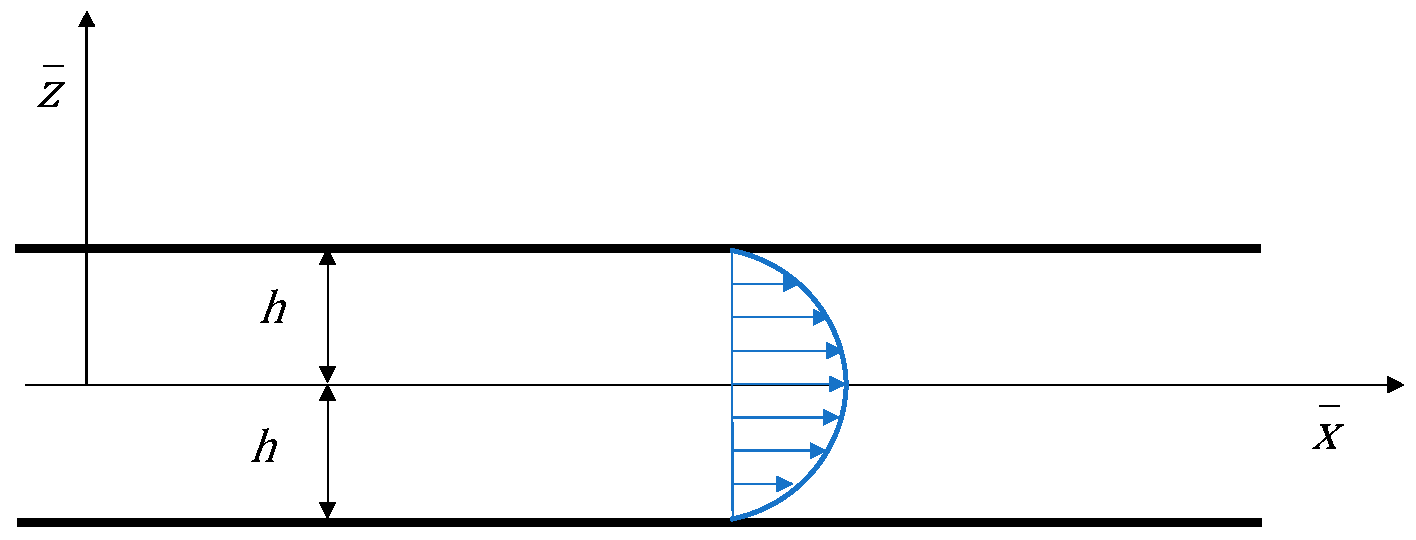
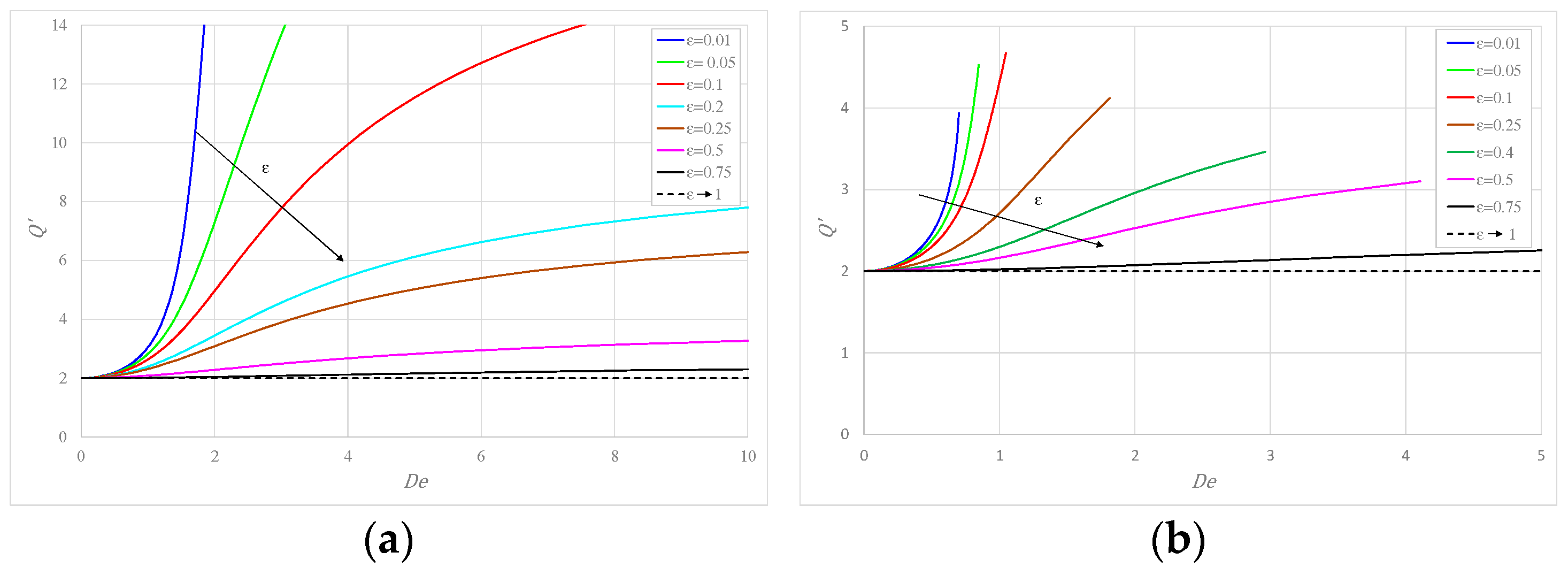
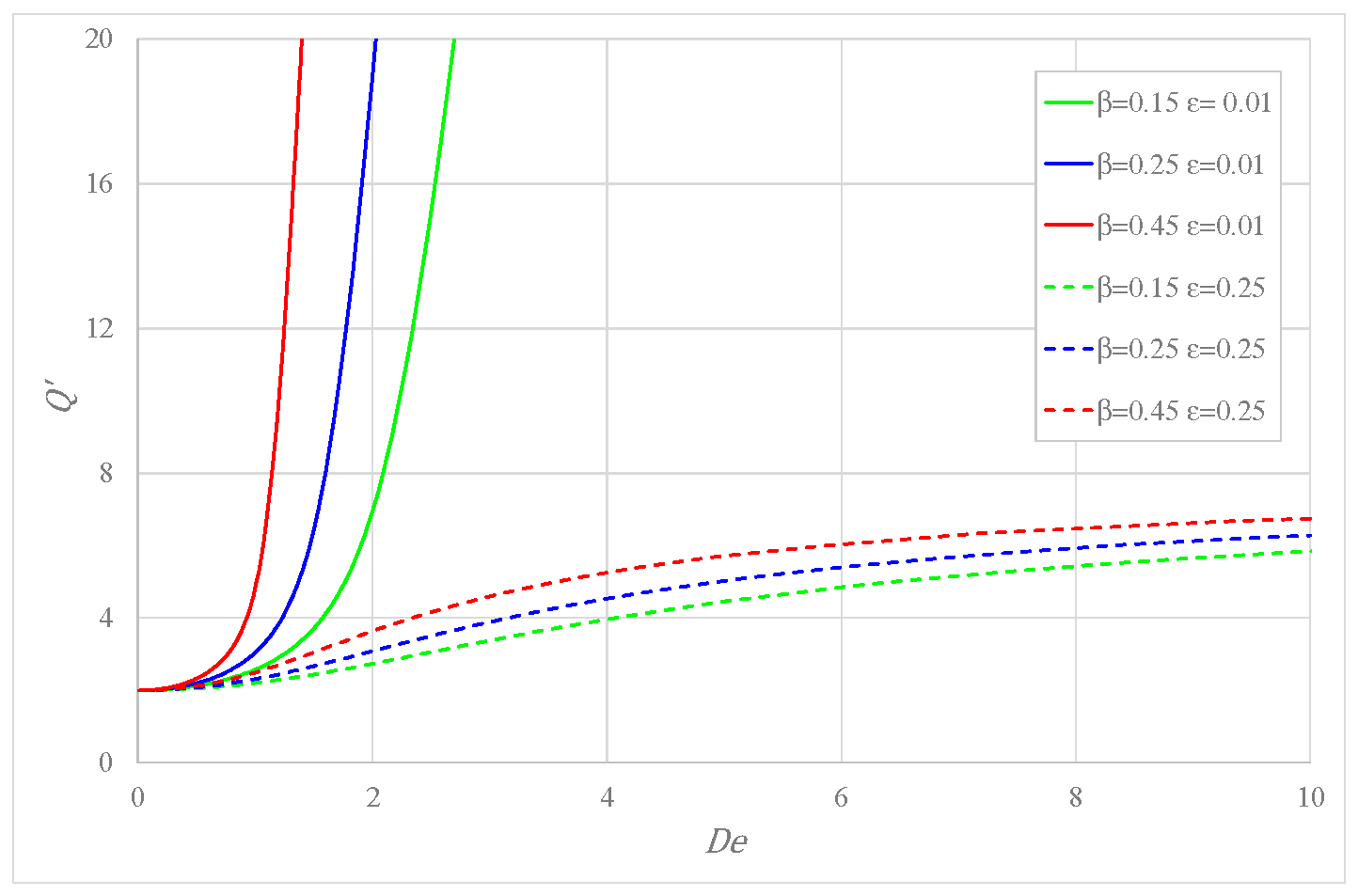
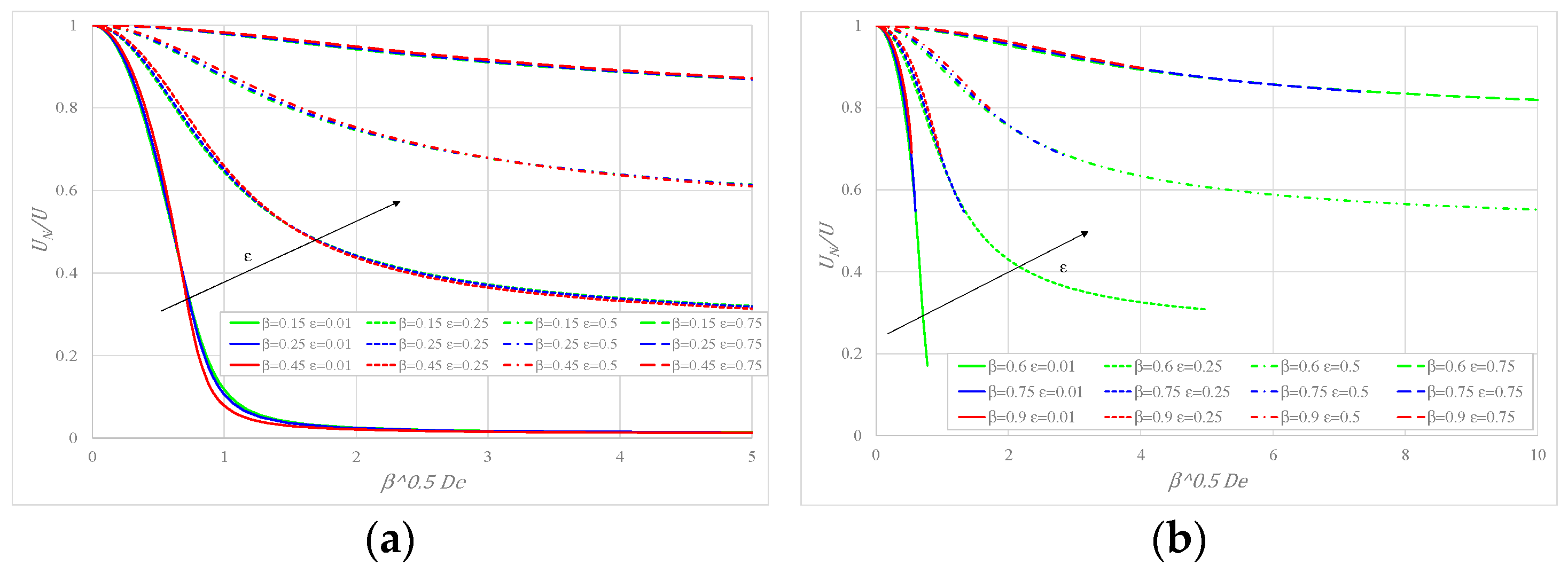
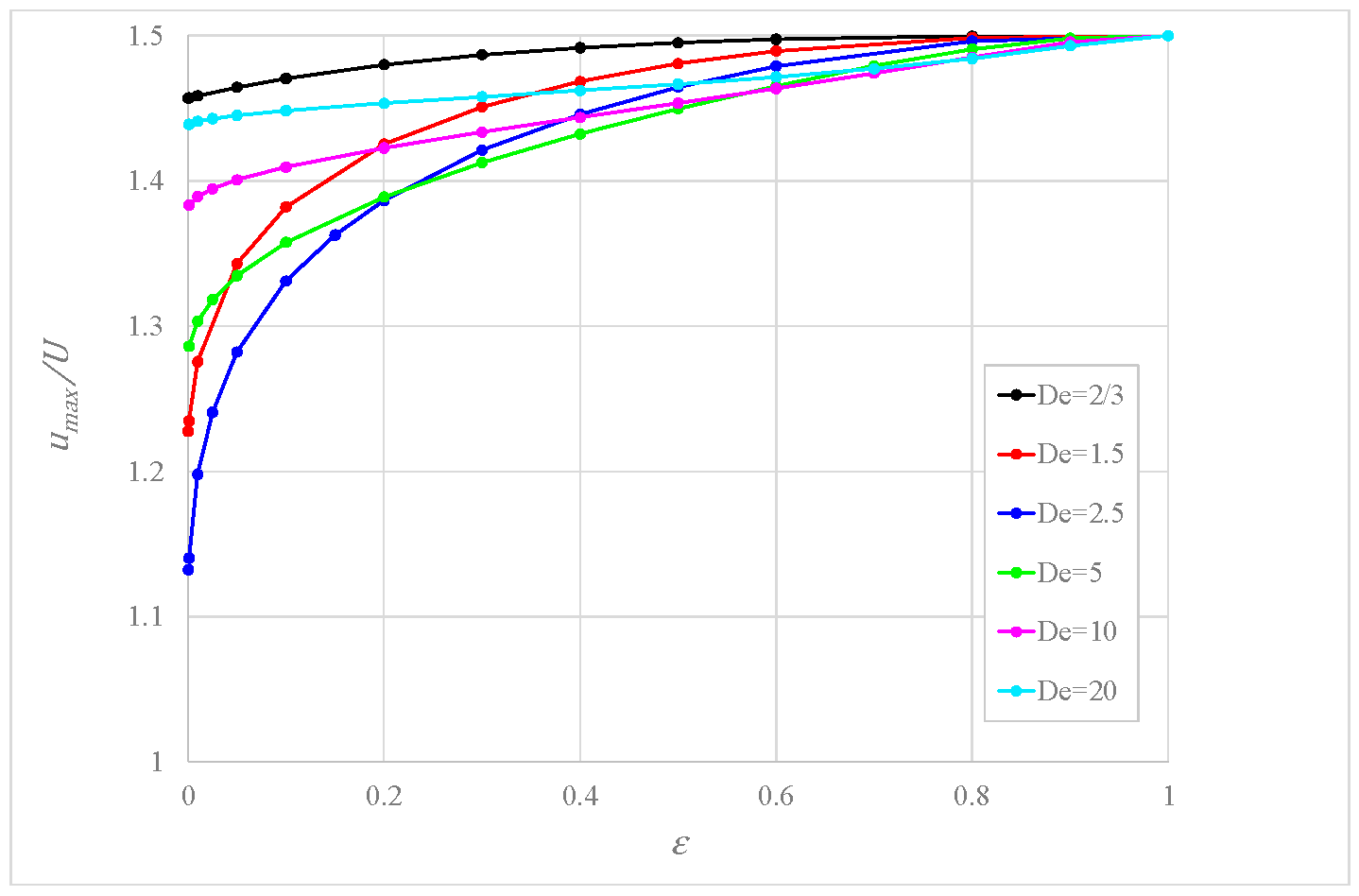
Disclaimer/Publisher’s Note: The statements, opinions and data contained in all publications are solely those of the individual author(s) and contributor(s) and not of MDPI and/or the editor(s). MDPI and/or the editor(s) disclaim responsibility for any injury to people or property resulting from any ideas, methods, instructions or products referred to in the content. |
© 2024 by the authors. Licensee MDPI, Basel, Switzerland. This article is an open access article distributed under the terms and conditions of the Creative Commons Attribution (CC BY) license (https://creativecommons.org/licenses/by/4.0/).
Share and Cite
Daprà, I.; Scarpi, G.; Di Federico, V. Impact of Addition of a Newtonian Solvent to a Giesekus Fluid: Analytical Determination of Flow Rate in Plane Laminar Motion. Fluids 2025, 10, 1. https://doi.org/10.3390/fluids10010001
Daprà I, Scarpi G, Di Federico V. Impact of Addition of a Newtonian Solvent to a Giesekus Fluid: Analytical Determination of Flow Rate in Plane Laminar Motion. Fluids. 2025; 10(1):1. https://doi.org/10.3390/fluids10010001
Chicago/Turabian StyleDaprà, Irene, Giambattista Scarpi, and Vittorio Di Federico. 2025. "Impact of Addition of a Newtonian Solvent to a Giesekus Fluid: Analytical Determination of Flow Rate in Plane Laminar Motion" Fluids 10, no. 1: 1. https://doi.org/10.3390/fluids10010001
APA StyleDaprà, I., Scarpi, G., & Di Federico, V. (2025). Impact of Addition of a Newtonian Solvent to a Giesekus Fluid: Analytical Determination of Flow Rate in Plane Laminar Motion. Fluids, 10(1), 1. https://doi.org/10.3390/fluids10010001







